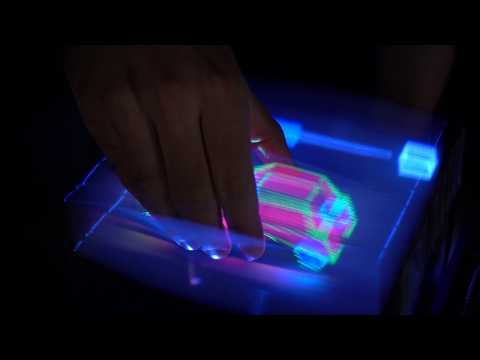| In Brief |
|
Technological advancements continue to amaze us, and the concept of manipulating three-dimensional holograms, reminiscent of sci-fi films, is gradually becoming a reality. This innovation, named FlexiVol, created by a team of Spanish engineers, promises to transform how we interact with the digital world, making interactions more intuitive and natural without the need for bulky devices. Let’s explore how this technology is already revolutionizing our daily lives and what the future may hold.
FlexiVol: A Pioneering Technology
FlexiVol stands out with its unique approach to volumetric display. This system utilizes elastic diffusers instead of traditional rigid surfaces, allowing users to manipulate holograms without the risk of injury or damaging the device. The choice of materials was crucial in achieving this feat. After extensive testing with various materials, the team selected specific elastic bands known for their elasticity and optical properties. This innovation marks a turning point in the field of holograms, making their interaction safer and more accessible.
The underlying technology relies on familiar gestures akin to those we use on our smartphone touchscreens. Users can easily manipulate holographic objects with swiping, rotating, or pinching gestures. This intuitive approach makes FlexiVol particularly appealing for those looking to integrate holographic solutions into their daily lives.
Impressive Performance
To evaluate FlexiVol’s effectiveness, a series of tests were conducted with 18 participants. They compared the use of FlexiVol technology to that of a 3D mouse, a traditional device for interacting with three-dimensional spaces. The results were compelling: users were quicker and more accurate with FlexiVol when selecting, tracing, and positioning objects. The direct interaction method using fingers proved to be far more intuitive than using a 3D mouse, which is often viewed as complex and unnatural.
The participants also expressed greater confidence in their performance with FlexiVol. In fact, 94% felt more assured in their completion times, and 67% were more confident in the accuracy of their actions. These results underscore FlexiVol’s potential to transform how we interact with digital environments.
Toward an Even More Advanced Interaction
Although FlexiVol is already a major leap forward, Dr. Elodie Bouzbib and her team are not stopping there. They plan to incorporate even more sophisticated technologies, such as focused ultrasound or conductive threads, to simulate haptic feedback. The goal is to make the user experience even more immersive and realistic. This ongoing improvement effort highlights the team’s commitment to innovation and the pursuit of excellence.
By integrating these new technologies, FlexiVol could offer tactile sensations, enhancing the feeling of manipulating real objects. This concept opens the door to potential applications across various fields, from medicine to education and entertainment.
Implications and Perspectives

With the development of FlexiVol, the future of interactive holograms looks promising. This technology could transform multiple sectors, ranging from the video game industry to healthcare, education, and professional training. The implications of FlexiVol are vast, offering nearly limitless possibilities for content creators and software developers.
As technology evolves, it’s crucial to consider the practical applications of FlexiVol and its potential impact on society. How could this innovation change our relationship with technology and reshape our daily interactions with the digital world?








